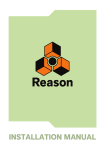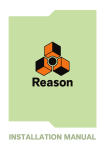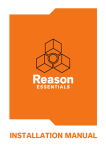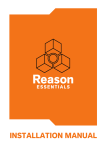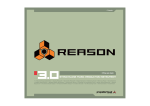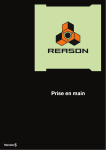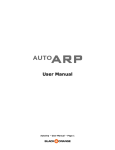Download Reason 6.5 Installation Manual
Transcript
INSTALLATION MANUAL The information in this document is subject to change without notice and does not represent a commitment on the part of Propellerhead Software AB. The software described herein is subject to a License Agreement and may not be copied to any other media expect as specifically allowed in the License Agreement. No part of this publication may be copied, reproduced or otherwise transmitted or recorded, for any purpose, without prior written permission by Propellerhead Software AB. ©2012 Propellerhead Software and its licensors. All specifications subject to change without notice. Reason, Reason Essentials and Rack Extension are trademarks of Propellerhead Software. All other commercial symbols are protected trademarks and trade names of their respective holders. All rights reserved. Table of Contents Introduction 7 Welcome! 8 About the Reason documentation 8 About the Reason operating system versions 8 What is in the Reason box? 9 The Reason installation DVD 9 The Ignition Key 9 Product authorization 9 The Reason download version 9 If you are upgrading from an earlier Reason version 9 Using the Reason download version while waiting for the box 9 Installation 11 Requirements 12 Mac OS X 12 Windows 12 About the Audio Hardware 13 Audio hardware and Mac OS X 13 If you are using the Propellerhead Balance audio interface 13 If you are using the built-in audio hardware in your Macintosh 13 If you are using other audio hardware with your Macintosh 13 Audio hardware and Windows 13 If you are using the Propellerhead Balance audio interface 13 If you are using other audio hardware with your Windows PC 14 About MIDI Interfaces 14 MIDI Connections 14 Installing the Software 15 Upgrading from an earlier Reason version 15 Running the Installer 15 About the Sound Banks on Mac OS X (DVD version only) 16 Authorization and the Ignition Key 16 Registering and authorizing Reason 16 4 TABLE OF CONTENTS Running Reason with the Ignition Key hardware 18 Running Reason with Internet Verification 18 Running Reason in Demo Mode 19 Setting Up 21 About this Chapter 22 First run - Reason Setup Wizard 22 About the Preferences 24 Setting up the Audio Hardware 25 Mac OS X 26 Windows 26 About Latency and other Audio Settings 26 Setting up MIDI 27 Adding a Control surface 28 If your control surface model isn't listed 30 About the Master Keyboard 30 Master Keyboard Input 31 Other functions 31 Setting up the Default Song 32 Opening the last Song at program launch 32 Reassigning the Function Keys in Mac OS X 33 TABLE OF CONTENTS 5 6 TABLE OF CONTENTS Chapter 1 Introduction Welcome! Thank you for choosing Reason! Whether you're a songwriter, beat maker, recording your band, or just love to make sounds, this is the beginning of a beautiful friendship. New in this version of Reason is Rack Extensions, Propellerhead's brand new plug-in format. Don't forget to visit the Propellerhead web site at www.propellerheads.se and read up on all the new Rack Extension instruments and effects created by ourselves and others that you can add to your rack. A driving force for us at Propellerhead is communication with all the people around the world that use our programs to realize their musical ideas. And a big part of this communication takes place on our own user forums. This is a unique meeting place where professionals and beginners meet on equal terms to exchange ideas. But even more importantly, it's a forum open to you. We think you will enjoy talking to other Reason users all over the world, just as much as we'll enjoy talking to you. Yours truly, The Propellerhead Team www.propellerheads.se About the Reason documentation This is the Installation Manual where installation of Reason and basic setting up procedures are described. Detailed features and operations in Reason are described in the Operation Manual pdf. This and other pdf documents are installed with the program - you find them in the Documentation folder inside your Reason application folder. The Operation Manual also contains reference descriptions of all Reason devices and commands. About the Reason operating system versions Reason runs under Mac OS X and Windows (for operating system details, see “Requirements”). All Reason packages contain program versions for both platforms. Everything said in the manuals applies to both platforms, unless explicitly stated. 8 INTRODUCTION What is in the Reason box? If you have purchased the boxed version of Reason, the package contains the following items: The Reason installation DVD This DVD contains the main Reason program installer which include the Reason application, Help System, Demo Songs and documentation. In addition, the Windows partition of the DVD also contains an installer for Adobe Acrobat Reader. The Ignition Key Reason comes with a protection hardware - the Ignition Key - which is a part of the Reason protection system. The Ignition Key hardware is built-in in the Propellerhead Ignition Key (USB stick) which should be plugged into a free USB port on your computer. The Ignition Key hardware needs to be authorized before use, see “Authorization and the Ignition Key”". Product authorization The license number and registration code required for the installation are printed on the DVD sleeve. The registration code is a one-time code used to register your Reason license to your Propellerhead user account. Once you have registered Reason to your account and authorized the Ignition Key, you don't need it any more. ! Note that if you bought Reason from the Propellerhead web shop, it is already registered to your account. The Reason download version If you are upgrading from an earlier Reason version ! If you are upgrading from an earlier version of Reason, there are some important things to consider before installing the new version, see “Upgrading from an earlier Reason version”. If you are upgrading from Reason 6 or later (or from Propellerhead Record), you already have an Ignition Key and won’t need the boxed version. After you have downloaded the Reason upgrade, unpacked the file and installed Reason, refer to “Registering and authorizing Reason” for details on how to authorize Reason. Using the Reason download version while waiting for the box If you have purchased the boxed version of Reason and are waiting for the shipment, you could meanwhile use the download version of the program and run it with full functionality using Internet Verification. Refer to “Running Reason with Internet Verification” for details on how to proceed. If this is your first acquaintance with audio recording and music production software, you might also want to check out the “About the Audio Hardware” and “About MIDI Interfaces” sections before continuing. ! When you receive the Reason box you should NOT reinstall the Reason program - everything you need has already been installed from the download version. However, you might want to authorize your Ignition Key hardware, see “Authorization and the Ignition Key”. INTRODUCTION 9 10 INTRODUCTION Chapter 2 Installation Requirements Below you will find the minimum requirements for running Reason: ! Note that these are the minimum requirements! You will benefit from a fast computer with lots of RAM, since this will allow you to use more devices at the same time. Mac OS X • • • • • • • • • • Intel Mac (multiple cores highly recommended) 2 GB RAM or more DVD drive 3 GB free hard disk space (program may use up to 20 GB scratch disk space) Mac OS X 10.5.8 or later (10.6.3 or later together with Propellerhead Balance) Monitor with at least 1024x768 resolution CoreAudio compliant audio interface, such as Propellerhead Balance, or built-in audio hardware Free USB port for Ignition Key hardware (a free USB2.0 port is necessary when using the Propellerhead Balance audio interface) Internet connection for registration and Rack Extension installation MIDI interface and a MIDI keyboard recommended Windows • • • • • • • • • • 12 Intel Pentium 4/AMD Opteron or better (multiple cores highly recommended) 2 GB RAM or more DVD drive 3 GB free hard disk space (program may use up to 20 GB scratch disk space) Windows XP (SP3), Vista or Windows 7 Monitor with at least 1024x768 resolution Audio Interface with ASIO driver, such as Propellerhead Balance Free USB port for Ignition Key hardware (a free USB2.0 port is necessary when using the Propellerhead Balance audio interface) Internet connection for registration and Rack Extension installation MIDI interface and a MIDI keyboard recommended INSTALLATION About the Audio Hardware The audio hardware is the computer equipment that converts the analog signals from instruments and microphones to digital signals that Reason can work with and store, and back again (for connection to an amplifier, headphones, or similar). This equipment could be a built-in audio card, a 2 channel USB interface, such as Propellerhead Balance, or a Firewire audio interface, or an audio card with several inputs and outputs, digital connectors, etc. Regardless of which, you need to make sure the hardware and its drivers are properly installed: Audio hardware and Mac OS X If you are using the Propellerhead Balance audio interface Please refer to the Propellerhead Balance Operation Manual pdf for information on how to install, connect and use the Propellerhead Balance audio interface. If you are using the built-in audio hardware in your Macintosh All Mac models come with a built-in audio interface, providing stereo input and output jacks (and in some cases a built-in microphone). Depending on your needs, the quality of these inputs and outputs may be fully sufficient for use with Reason. Reason provides a number of pre-configured Input(s)+Output(s) combinations that can be accessed from the Audio tab in Preferences. If you are using other audio hardware with your Macintosh You may want to use other audio hardware with Reason (e.g. an audio interface with multiple outputs, digital connections, etc.). For this to be possible, the audio hardware must be compatible with Mac OS X, i.e. there must be a Core Audio driver available for the hardware. 1. Install the audio hardware drivers as described in its documentation. Note that some audio hardware does not require any special audio drivers. Please, refer to the hardware documentation. 2. Connect the stereo outputs of your audio hardware to your listening equipment (speakers, mixer, headphones or similar). For info about how to use multiple outputs (i.e. more than a stereo output), see the Operation Manual pdf. For now, we stick to standard stereo connections. 3. If possible, test that audio plays back OK with the audio hardware. With some audio hardware, a test application is supplied for this purpose. Audio hardware and Windows If you are using the Propellerhead Balance audio interface Please refer to the Propellerhead Balance Operation Manual pdf for information on how to install, connect and use the Propellerhead Balance audio interface. INSTALLATION 13 If you are using other audio hardware with your Windows PC ! To run Reason with full audio in and audio out functionality under Windows, an ASIO driver is required for the audio hardware. Reason can run with DirectX or MME drivers as well but this will only support audio out - and at considerably higher latencies than with ASIO drivers. 1. Make sure you have the latest ASIO driver for the audio hardware! Please check the manufacturer's web site for the latest versions. 2. Install the audio hardware drivers as described in its documentation. 3. Connect the stereo outputs of your audio hardware to your listening equipment (speakers, mixer, headphones or similar). For information about how to use multiple outputs (i.e. more than a stereo output), see the Operation Manual pdf. For now, we stick to standard stereo connections. 4. If possible, test that audio plays back properly with the audio hardware. In the case of audio hardware with ASIO drivers, you will need some test application for this (often included with the audio hardware). About MIDI Interfaces While it is possible to use Reason without an external MIDI controller (by only using the “On-screen Piano Keys” window for playing MIDI notes, or by manually drawing notes and automation in the sequencer), this would not allow you to use the program to its full potential. From now on we assume that you are using a MIDI interface and some kind of external MIDI controller (typically a USB-keyboard with a built-in MIDI interface). D When installing the MIDI interface and its drivers, follow the instructions in its documentation carefully. • While a MIDI interface with a single input is sufficient, you will benefit from having two or more individual inputs. This is especially true if you want to manipulate Reason parameters with additional MIDI control surface devices, or use the program in conjunction with an external, stand-alone sequencer, drum machine or similar. • For some MIDI interfaces connected via USB, no driver installation is required. Just plug in the interface and you're ready to go! • For other, more advanced MIDI interfaces (or at least to take advantage of more advanced features, like multiple inputs) you will need to install a driver. Please consult the documentation that came with the interface for details. MIDI Connections D Simply connect the USB cable from your keyboard to your computer. Or D Connect a MIDI cable from the MIDI Out on your MIDI keyboard (or other MIDI controller) to a MIDI In on your MIDI interface. This is sufficient to be able to play and record notes and controllers in Reason from the MIDI keyboard. 14 INSTALLATION • If you are not using a USB keyboard, you may also connect the MIDI Out from the MIDI interface to the MIDI In on your MIDI keyboard. This is not strictly necessary to use Reason, but it will enable two-way communication when you run the Reason Setup Wizard which appears the first time Reason is launched (see “First run - Reason Setup Wizard”), or when using Auto-detect Surfaces in the Preferences (see “Adding a Control surface”). Whether auto-detection works or not depends on the keyboard model. ! If you have several MIDI control surfaces or similar that you want to use, we recommend that you connect them to separate MIDI ports (or directly to the computer using USB). Installing the Software Upgrading from an earlier Reason version If you are upgrading from an earlier version of Reason, there are some important things to remember before installing the upgrade: ! Before uninstalling your current Reason version and installing the new version, make sure you don’t leave anything you want to keep in the Reason program folder; the Reason program folder and its contents will be permanently deleted during installation of the upgrade! For example, move any additional ReFills etc. from the Reason program folder to another (temporary) location before upgrading, otherwise the files might be permanently deleted. D If you are upgrading from Reason Version 6, you may also want to move the Factory Sound Bank.rfl and Orkester.rfl to a temporary location before installing. These sound banks are exactly the same for Reason Version 6.5, which means that after you have upgraded to the new version you can move these files back to the Reason program folder. In this situation you can upgrade using the smaller Reason Version 6.5 update file (which doesn’t contain the sound banks). Running the Installer Now it's time to install the actual Reason software: D Insert the Reason disc into your DVD drive - or unzip the download file (Windows) or mount the disk image file (Mac OS X). What to do next depends on whether you are installing on a Mac or a Windows computer. Windows: 1. Locate the file called "Install Reason.exe" and double click it. The installer may automatically start when you insert the DVD, depending on your system settings. • If you run a 64-bit Windows OS, the 64-bit version of Reason will be installed. • If you run a 32-bit Windows OS, the 32-bit version of Reason will be installed. 2. Follow the instructions on screen. Before executing the installation of the software components, you will be asked to select a language, an install location, and whether you wish to create a program shortcut/alias on your desktop. When the installation is complete, you have the option of launching Reason directly. Mac OS X: D On the Mac, there is only a folder called “Reason” - simply drag this to the “Applications” folder on your hard disk. Both 64-bit and 32-bit versions are included in the application. When you later launch Reason, it will run in 64-bit or 32-bit mode depending on your operating system. INSTALLATION 15 Both platforms: • During the installation on Windows, or during the first program launch on Mac OS X, the CodeMeter and Authorizer applications will be installed on your computer. The applications are necessary for handling the Reason authorization (see below) and administration of Rack Extension devices. ! CodeMeter and Reason communicate with each other via a local network connection. You must therefore allow CodeMeter and Reason access to the Internet if you are using a firewall program. D When the installation is completed, don’t forget to activate your anti-virus software again (if applicable). About the Sound Banks on Mac OS X (DVD version only) The first time you launch Reason under Mac OS X, you will be asked to insert the Reason disc to copy the Factory Sound Bank and Orkester sound bank to your hard disk. The Factory Sound Bank and Orkester sound bank are two big files, containing a large number of patches, samples and loops, serving as your main supply of sounds (much like the sound ROM in a synthesizer). These are copied to your hard disk and are required to run the program. Authorization and the Ignition Key Reason uses an authorization system designed to be as flexible as possible, while at the same time providing the best possible copy protection for the product. Here's how it works: • • • • The core of the authorization system is your license number, which is registered to your user account on the Propellerhead web site. You then use this license to authorize your Ignition Key hardware (fitted in an Ignition Key (USB stick) or built-in in the Propellerhead Balance audio interface). You can then use the Ignition Key (USB stick) or Propellerhead Balance audio interface to run Reason in authorized mode, anywhere and on any computer. If you don't have an Ignition Key hardware at hand, you can still run Reason in authorized mode, provided that you have a working Internet connection. The program will then contact the Propellerhead web site and verify that Reason is registered to your user account. Finally, if you have no Ignition Key hardware at hand, nor a working Internet connection, you can run Reason in Demo Mode. This is also the mode you use if you are trying out the program, but haven't yet purchased it. In this mode, you can work as usual and even save your work. You cannot, however, open songs in Demo Mode (for details, see “Running Reason in Demo Mode”). Registering and authorizing Reason To be able to run Reason in authorized mode (see “Running Reason with the Ignition Key hardware” and “Running Reason with Internet Verification”), the program must be registered to your account on the Propellerhead web site. ! If you purchased Reason directly from the Propellerhead web site, the Reason license has already been registered to your user account and you can use Reason with Internet Verification. This means that you can run Reason using Internet Verification right away (see “Running Reason with Internet Verification”). However, when you receive your Propellerhead Ignition Key hardware you need to authorize it, so please read on! 16 INSTALLATION Here's how you register and authorize your copy of Reason: ! Note that a working Internet connection is required to be able to perform the following steps. 1. Launch Reason. When you start Reason for the first time, the following window appears: 2. Click on the Register and Authorize button. Your default web browser starts up and takes you to the Login page at the Propellerhead web site. 3. Enter your user name and password and log in on your Propellerhead account. If you don't have an account already, click on the "Create account" link and follow the instructions to register a new account. 4. The following step depends on the situation: If you purchased the boxed version of Reason and haven't yet registered the program, you will be asked to do that: D Enter the license number and registration code found on the DVD sleeve in the Reason box, then click the Register button. A new web page appears where you are asked if you want to write your license to your Ignition Key hardware or do it later. If you click the Later button, you will be able to run Reason using Internet Verification, see “Running Reason with Internet Verification”. When you have registered Reason and now want to write your license to your Ignition Key: D Click the Write License button. This will take you to the “Manage Licenses” page where you can choose to write your Reason license to your Ignition Key. INSTALLATION 17 5. Follow the instructions on the web page to write your licence to your Ignition Key. 6. When you're done, Reason will continue launching and you will now be able to run the program in Authorized Mode. You can now quit the web browser if you like. Running Reason with the Ignition Key hardware If you launch Reason with an authorized Ignition Key hardware (Propellerhead USB stick or Propellerhead Balance audio interface) connected, the program will simply start without further ado. q From now on, always connect the Ignition Key hardware before starting your computer and launching Reason. This way Reason will start up immediately, without the Authorization procedure. When you have an authorized Ignition Key hardware connected to your computer, it’s no longer necessary to have Internet connection when running Reason. Running Reason with Internet Verification If you launch Reason without an Ignition Key hardware connected, the following window appears: 1. Click on the "Run with Internet verification" button. ! Note that this requires a working Internet connection (and that your Reason license has been registered to your user account as described in “Registering and authorizing Reason”). 2. Enter the Username and Password for your Propellerhead account in the dialog that appears. Reason launches in authorized mode. 18 INSTALLATION • Should you at any point connect your authorized Ignition Key hardware, Internet connection is no longer required. ! It is not possible to run two instances of Reason (on different computers) authorized to the same user account. Reason will then enter Demo Mode. Running Reason in Demo Mode If you don't have a Reason license, or if you don’t have your Ignition Key hardware at hand and don’t have a working Internet connection, you can run Reason in Demo Mode: 1. Launch Reason. The following window will show up: 2. Click on the "Run in Demo Mode" button. Reason launches in Demo Mode. The Demo Mode indicator lights up to the left on the Sequencer Transport Panel. Running Reason in demo mode allows you to perform all operations as in authorized mode, with three exceptions: • • You cannot export audio or bounce mixer channels to disk. You will not have access to any Rack Extension devices. INSTALLATION 19 • You cannot open songs. The only songs that can be opened in demo mode are the dedicated demo songs (file extensions ".rsndemo" (Reason Demo Song), ".reedemo" (Reason Essentials Demo Song) and ".recdemo" (Record Demo Song)). Demo songs can be accessed from the “Open Demo Song” item in the File menu. If you disconnect your Ignition Key hardware, or lose the Internet Connection while running Reason with Internet Verification, the program will automatically enter demo mode. You can continue to work, and save your songs as usual. When you reconnect the Ignition Key hardware or reconnect to the internet, Reason will automatically revert to authorized mode and the Demo Mode indicator will go off. 20 INSTALLATION Chapter 3 Setting Up About this Chapter This chapter describes the settings you need to make before you can start using Reason. These are necessary in order to get any sounds to and from the program and to be able to play and control Reason via MIDI. First run - Reason Setup Wizard If you followed the instructions correctly in the last chapter, Reason should be running, and the first dialog in the "Reason Setup Wizard" guide should be open. This only appears the very first time the program is run. ! Note that the Language page only appears in the Windows version of Reason. In Mac OS X, the selected system language is used. ! Note that any setting you make in the Setup Wizard can be changed later on in the Preferences dialog. D Clicking “Next” will take you through a series of dialogs, where the following happens: 22 SETTING UP • • The Setup Wizard will first try to find a compatible audio driver. It will automatically select the first compatible driver it finds. If this is the driver you wish to use, fine. If it isn't, select your preferred driver from the Audio Card Driver pop-up. If you don't know which driver to use, see “Setting up the Audio Hardware”. Next, Reason will try to auto-detect a Master Keyboard. If one is found and you want to use this, click "Use" and proceed. ! For Reason to auto-detect a device you need two-way MIDI communication! Non-USB keyboard devices without a MIDI input can of course still be added manually. ! Note that your keyboard model might not be auto-detected by Reason, even though it’s a modern one and connects via USB. However, you can still use such a keyboard to control Reason in the same way as with an auto-detected keyboard. • If Reason can't find the keyboard you have connected, or if you clicked "Don't Use", you will be asked to specify a Master Keyboard manually. This is done by first selecting a manufacturer, and then a model. If your model keyboard isn't on this list select "Other". D You will also have to specify a MIDI port to use. This can be done either by selecting one of the available ports listed in the popup, or by clicking the "Find…" button and pressing some keys on your keyboard. D Note that if you have additional remote control surface devices in your setup, these will have to be added in the Preferences - see “Adding a Control surface”. The Setup Wizard will only establish a connected Master Keyboard device. Setup is now complete! If all went well, you should now have established audio and MIDI communication - the basics needed to record and play back audio and to direct MIDI to Reason! However, if for any reason the Setup Wizard failed to establish the necessary settings, or if you wish to add other devices etc., you will have to make your settings in the Preferences dialog (see below). D Select which song to open, and if you want to watch the video tutorials on the Propellerhead web site. The final page of the Setup Wizard let's you select if you want to open a Demo Song, a template document, or an empty song directly after finishing the Setup Wizard. It also gives you an option to watch video tutorials on the Propellerhead web site. SETTING UP 23 About the Preferences The basic settings for audio and MIDI are done in the Preferences dialog. This is opened from the Edit menu (or, if you are running Mac OS X, from the Reason menu). The Preferences dialog. q Described herein are only the most important settings in the Preferences. For information about other Preferences settings, see the “Menu and Dialog Reference” chapter in the Reason Operation Manual pdf. 24 SETTING UP Setting up the Audio Hardware In case this wasn't done in the Setup Wizard, you need to establish a connection between Reason and the audio hardware. This is done by selecting a driver - a software component that acts like a link between the program and the audio hardware. Proceed as follows: 1. In the Preferences dialog, click the Audio tab. 2. Pull down the Audio card driver pop-up menu and select one of the available drivers. Which driver to select depends on the platform and the audio hardware. If an option is not applicable to your setup it will be disabled in the dialog. SETTING UP 25 Mac OS X D Select the option that corresponds to the hardware you want to use (the built-in audio connectors or some additional audio hardware that you have installed). q A number of predefined combinations of built-in inputs and outputs will also be available in the Audio Card Driver pop-up. The number of available input(s)+output(s) combinations depends of your computer’s specific audio hardware configuration. Windows ! If you run Reason under Windows, it’s required that the audio hardware supports ASIO drivers, otherwise you won’t be able to record any audio. D Select the option that corresponds to the ASIO hardware you want to use. If you are using audio hardware for which there is a specific ASIO driver, you should select this. With an ASIO driver written specifically for the audio hardware, Reason can communicate more or less directly with the audio hardware. The benefits are lower latency (see below) and possibly better support for additional hardware features such as multiple inputs and outputs. About Latency and other Audio Settings On the Audio tab, you will find a number of additional settings for audio. The most important ones are Buffer Size and the corresponding readouts for Input and Output Latency. The Input Latency is the delay between when the audio is “sent” from a connected microphone or instrument and when it’s received and detected by Reason. Output Latency is the delay between when audio is “sent” from Reason and when you actually hear it. The latencies in an audio system depends on your audio hardware, its drivers and their settings. When you select a driver, its latency values are automatically reported by the audio card and displayed in the on the Audio tab in Preferences. Depending on the audio hardware and the driver, you may be able to adjust these values. If you experience high latency values, you will need to make adjustments to your configuration. D If available, use the Buffer Size slider to lower the latency. D If the Buffer Size slider is disabled, you may be able to lower the buffer size in the control panel for the audio hardware - click the Control Panel button to open this. For more information, please consult the Reason Operation Manual pdf. 26 SETTING UP Setting up MIDI In Reason, MIDI keyboards or remote control devices are called control surfaces. MIDI input from control surfaces is handled by a system called Remote. Here are some of the main features: • • • • • • • You can use any number of control surfaces at the same time. The program supports a large number of control surfaces out of the box - knobs, faders and buttons on the surfaces are automatically mapped to the most useful parameters on the Reason devices. You don't have to change the settings on the control surface to control different devices in Reason - if you change MIDI input from a ID-8 track to a Combinator track, the control surface will automatically adapt. You just set up your control surface once and for all for use with Reason - the program handles the rest! For control surfaces that are not natively supported at this stage, you can use generic drivers. Note however, that Remote drivers for additional control surfaces will be added continuously - check our web page for more info. By default, all control surfaces follow the sequencer Master Keyboard Input. This means that you set MIDI input to a track in the sequencer to route the control surface(s) to the track's device in the rack. You can lock a control surface to a specific device in the rack. For example, you could have a Master Keyboard that follows MIDI input, while another control surface is locked to the Main Mixer. This way you can control levels and pans at all times. This is described in the Operation Manual. You can use remote overrides to map a specific control on a surface to a specific Reason parameter or function. For example, you could override-map a knob or fader on your control surface to the Main Mixer's master level fader. Or you could map buttons on your control surface to control Reason's transport (play, stop, record, etc.) at all times, regardless of which track has Master Keyboard Input in the sequencer. This is described in the Operation Manual. Remote also supports some control surfaces with MIDI feedback. If you have such a control surface and it is supported by Reason, you can take full advantage of motorized faders, meters, displays, etc. Among the Reason documentation you will find a pdf document called "Control Surface Details". This contains useful information about the supported control surfaces. In case you specified a Master Keyboard in the Setup Wizard, and you don't have any other control surfaces, you don't have to do anything else. But if you want to add additional control surfaces or edit your settings, this is done in the Preferences. SETTING UP 27 Adding a Control surface 1. Open the Preferences dialog and click the Control surfaces tab. 2. If your control surface is connected via USB (or if you have made a two-way MIDI connection), try clicking the Auto-detect Surfaces button. Reason scans all MIDI ports and tries to identify the connected control surfaces. Note that not all control surfaces support auto-detection. All found surfaces are listed in the Attached Surfaces list. 3. To add a control surface manually, click the Add button. This brings up a new dialog. 4. Select the manufacturer of your control surface from the Manufacturer pop-up menu. If you can't find it on the menu, see below. 5. Select the model of your control surface from the Model pop-up menu. If you can't find it on the menu, see below. 28 SETTING UP 6. An image of the selected control surface model is shown, often along with some information text - read this carefully. For some control surfaces, you need to select a specific preset to use the surface with Reason - this is noted here. 7. Use the MIDI Input pop-up to select the input port to which you have connected the surface. If in doubt, you can click the Find button and then tweak a control or play a key on the control surface to have Reason find the correct input port for you. • Some control surfaces may have more than one MIDI Input pop-up menu. You need to select ports on all MIDI Input pop-up menus. • Some control surfaces will have a MIDI Output pop-up menu. In some cases this labeled "Optional" - then you don't have to make a selection. In other cases, a MIDI Output is required. This is the case if the control surface uses MIDI feedback - motor fader, displays, etc. 8. If you like, you can rename your control surface in the Name field. 9. Click OK to add the surface. Depending on the surface model, alerts may appear, reminding you to select a specific preset etc. In some cases, Reason can restore a preset in the control surface to factory settings for you - you are then informed of this. Finally you return to the Keyboards and Control Surfaces tab in Preferences, where your added surface is now listed. SETTING UP 29 If your control surface model isn't listed If you can't find your control surface listed on the Manufacturer or Model pop-up menus when you try to add it, this means that there's no native support for that model. However, the program supports generic keyboards and controllers. Here's what to do: D Select "Other" on the Manufacturer pop-up menu and then select one of the three options on the Model pop-up menu. Or, if the Manufacturer is listed but not your specific model: D Select one of the three "Other" options on the Model pop-up menu: In both cases, the options are: • • • • MIDI Control Keyboard Select this if you have a MIDI keyboard with programmable knobs, buttons or faders. You need to set up your MIDI control keyboard so that the controllers send the correct MIDI CC messages, depending on which Reason device you want to control - check out the MIDI Implementation Chart in the Reason documentation. If your control surface has templates or presets for different Reason devices, these can be used. MIDI Control Surface Select this if you have a MIDI controller with programmable knobs, buttons or faders (but without keyboard). Again, you need to set your controllers to send the correct MIDI CCs. MIDI Keyboard (No Controls) Select this if you have a MIDI keyboard without programmable knobs, buttons or faders. This is used for playing only (including performance controllers such as pitch bend, mod wheel, etc.) - you cannot adjust Reason device parameters with this type of control surface. MIDI Multichannel Control Keyboard/Surface These options can be used if your MIDI keyboard or surface can handle multiple MIDI channels simultaneously. After selecting a model, proceed with selecting MIDI input as described above. About the Master Keyboard One of the control surfaces can be the Master Keyboard. This is like any other control surface, but it must have a keyboard and it cannot be locked to a specific Reason device (in other words, it always follows the MIDI input to the sequencer). This is the surface you use to play the instrument devices in Reason. • The first surface with a keyboard that is added (or found by auto-detect) is automatically selected to be the Master Keyboard. This is shown in the Attached Surfaces list on the Preferences page. D If you want to use another surface as Master Keyboard, select it in the list and click the "Make Master Keyboard" button. You can only have one Master Keyboard. D If you don't want to use any Master Keyboard at all, select the current Master Keyboard surface and click the same button (which is now labeled "Use No Master Keyboard"). 30 SETTING UP Master Keyboard Input This allows you to set a preference for how Master Keyboard Input mode is selected: • • Standard mode This always sets Master Keyboard Input to the selected track. Separated mode This will allow you to independently select tracks while Master Keyboard Input is unchanged. When this is mode is active, Master Keyboard Input is set by clicking the device icon in the track list. Selecting another track (by clicking on the track name or somewhere in the track list), leaves Master Keyboard Input unchanged. Other functions D To edit a surface, double-click it in the list (or select it and click Edit). This lets you change its name and MIDI port settings, if needed. D To delete a surface, select it in the list and click Delete. D You can turn off a surface by deactivating its "Use with Reason" checkbox. This could be useful if the surface is connected to your system but you only want to use it with another program, etc. • There is also an "Advanced Control" page in the Preferences. This is only used for External Control MIDI buses and for MIDI Clock Sync input. All hands-on MIDI control is set up on the Control surfaces page. SETTING UP 31 Setting up the Default Song It's possible to select a default Song which will automatically open as a "template" each time you select "New" from the File menu. The Default Song could be any Song you have created earlier, or a factory made Template Song. You can select this Default Song on the General tab in Preferences. 1. Select "Preferences" from the Edit menu (Win) or "Reason" menu (Mac) and then click the General tab. 2. Click the "Template" radio button in the "Default Song" section. 3. Click the folder icon to the right and select the Song you want to use as template when creating new Songs. Each time you create a new Song (by selecting "New" from the File menu), the selected Song will be loaded and used as a template for your new Song. On Windows platforms, the Song document will be named "Document n" where "n" is an incremental number. On Mac OS X platforms, the document will be named "untitled n" where "n" is an incremental number. You can then save your Song with a new name. Opening the last Song at program launch It's possible to instruct Reason to automatically open the last Song each time you launch Reason. You select this on the General tab in the Preferences dialog. 1. Select "Preferences" from the Edit menu (Win) or "Reason" menu (Mac) and then click the General tab. 2. Tick the "Load Last Song On Startup" checkbox. When you launch Reason the next time, the last saved Song will automatically open in a document window. 32 SETTING UP Reassigning the Function Keys in Mac OS X When you work with Reason, you will do a lot of navigating between the three main areas - the main mixer, the rack and the sequencer. The quickest way to switch between these areas is to use the function keys F5, F6 and F7 (see “Navigating between the areas” in the “Common Operations and Concepts” chapter in the Operation Manual and Help system for details). Also, the F3, F4 and F8 keys are shortcuts for showing and hiding the Recording Meter window, On-screen Piano Keys window and the Tool Window, respectively. However, on many Macintosh models (especially MacBooks), the function keys double as hardware control buttons. For example, they might control the volume of the built-in speaker, the display brightness or keyboard backlight. To make these keys actually work as function keys for software such as Reason, you need to hold the "Fn" key while pressing them. This can work perfectly OK, but to get the best workflow in Reason we recommend that you change this behavior, so that pressing e.g. the F5 key actually sends "F5" to Reason (and you hold down the Fn key to get the hardware control functions instead). Here is how you change this: 1. Open the System Preferences in Mac OS X and select the "Keyboard & Mouse" item. The "Keyboard & Mouse" preferences are shown. 2. Select the "Keyboard" tab and make sure the checkbox "Use all F1, F2, etc. keys as standard function keys" is ticked. Now you can use F3-F8 for controlling functions in Reason. To use hardware control features such as volume and display brightness, you need to hold down the "Fn" key before pressing the function keys. Some function keys might also be pre-assigned to Mac OS X keyboard shortcuts, which will have priority over software such as Reason. This is easily changed: 3. Click the “Keyboard Shortcuts” tab in the “Keyboard & Mouse” window. The Keyboards & Mouse Preferences window shows a list of keyboard shortcuts assigned to system functions. For example, [Cmd]-[F5] is assigned to turn VoiceOver on or off. In Reason, this is the keyboard shortcut for detaching the main mixer into a separate window. SETTING UP 33 4. Scroll down to the "Turn VoiceOver on or off" item and either remove the tick from the checkbox or assign it to another keyboard shortcut. 5. Scroll down further to the "Spaces" item (keyboard shortcut F8) and either remove the tick from the checkbox or assign it to another keyboard shortcut. In Reason [F8] is assigned to show/hide the Tool Window. 6. Now, you’re finished with the settings and can close the “Keyboard & Mouse” window. From now on, the function keys and keyboard shortcuts will perform their intended functions in Reason. 34 SETTING UP


































